Hello and welcome to you all!
Last Thursday afternoon, I was visited by Christopher Gosselin, who was a youth minister in the archdiocese and is now a campus minister at Salve Regina University in Newport. He brought a group of students to do service projects here in the archdiocese, particularly the homeless and others. He brought them to meet with me at the Cathedral and have them talk a little bit about their experience and their faith.


We had a nice conversation with them and they gave me a beautiful paperweight with the Salve Regina prayer in Latin.


After our meeting, they had a chance to take a tour of the cathedral.
– – –
Thursday evening, I visited Immaculate Conception in Revere to preside at a celebration for those participating in the catechesis of the Neocatechumenal Way in that parish. It was a wonderful group of nearly 100 people.

During the celebration, each person is presented with a bible by the bishop, as a sign of receiving the Word of God from the Church. Many of these ceremonies in the Neocatechumenal Way parallel the RCIA ceremonies, because it is a deepening of one’s baptismal commitment.
In my visit to the parish, I was deeply impressed by how the Hispanic community has grown exponentially with Father George Szal and Father Carlos Flor there. We are very grateful for that. There was wonderful enthusiasm among the people and their dedication to the parish was very heartening.
I also took a picture of the altar which came from the original church, which had a fire several years ago, but they were able to preserve the altar in the new building. 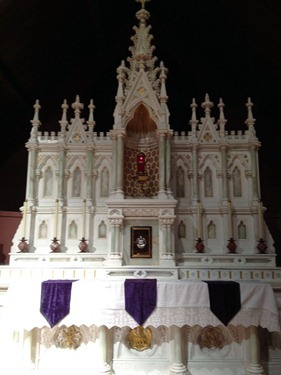
I thought it was just magnificent.
– – –
On Friday morning, I had one of my regular meetings with the auxiliary bishops. During those meetings they typically give me an update on what is going on in the regions. In this particular meeting they gave me updates about ways the bishops can help promote vocations as they visit parishes for confirmations. They had some very good suggestions and we will be discussing them with the Presbyteral Council.
– – –
That evening I met with the seminarians at St. John’s Seminary for evening prayer, a holy hour and dinner.
Then, after dinner, I had a time of dialogue with them. I also used the opportunity to speak to them about the HHS regulations and the issue of physician assisted suicide.


Then, since it was a Friday night, I led them in the Stations of the Cross.
– – –
Saturday, of course, was St. Patrick’s Day, the patronal feast for the archdiocese. 
St. Patrick is a wonderful patron: A great missionary who turned his enemies into his brothers and sisters in the Lord and who forgave his captors and oppressors and loved them enough to bring the light of Christ and the gospel to the Irish people.
His great genius as a missionary was to turn the Irish people into being a missionary church. Historically, the Irish had an extraordinary influence on the spread of Christianity throughout Europe. And, with the Irish emigration because of the famine and religious persecution in Ireland, Irish Catholics went on build up the Church all over the world.

I always reflect on the fact that one of the oldest churches in Puerto Rico, built for the slaves, is San Patricio. And when I was at World Youth Day in Australia and was involved in catechesis in four churches, three of them were named for St. Patrick. And then, on the Caribbean island of Montserrat, which is where many Irish indentured servants intermarried with African slaves, the patron of the island and the Church there is St. Patrick. So, wherever you go in the world you are going to find the spiritual children of St. Patrick in the Church.
The celebration at the Cathedral was glorious. We had a full Cathedral. There were two choirs from Dublin, bagpipers, step dancers and festive celebrations featuring Irish soda bread. 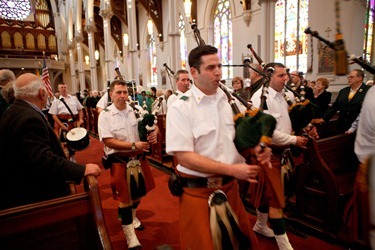

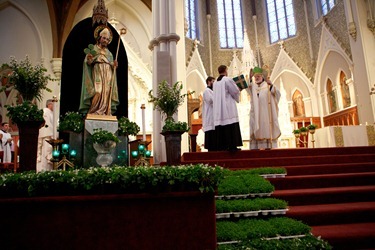






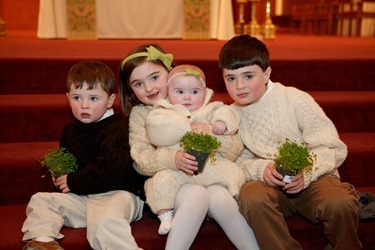
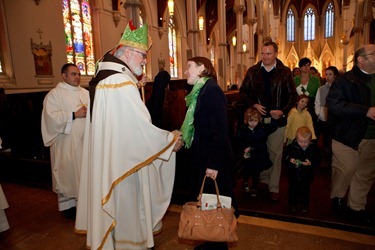



All of the people were able to receive the shamrocks that were blessed during the Mass to take home.
– – –
That evening, I was invited to give the invocation at the banquet held at the Fairmont Copley Hotel to mark 275th anniversary of the Charitable Irish Society — one of the oldest Irish organizations in the United States.

It was founded in Colonial Boston, in 1737, and remains an active organization promoting immigrants’ rights and helping immigrants. During the time of the famine they were very involved in sending aid to Ireland. Most people do not realize that, in the colonial times, many of the people who came from Ireland were actually Presbyterian Scotch-Irish; they were “Orangemen”, as we call them.
They were the founders of this organization, which was founded by King George and, during colonial times, there were members who were both patriots and loyalists to the crown.
After the Revolution, they admitted Catholics. (60 years before the Irish got the vote in Boston they were allowed to join the Irish Charitable Society.) So, they have interesting history of bringing together people who ordinarily would have been “on the other side of the aisle”, so to speak. However, I observed that the Orangemen probably made a mistake in letting the Catholics in because we seem to have taken over!
During the evening, a number of people received the organizations’ Lifetime Achievement Award including: Sister Janet Eisner, the president of Emmanuel College, poet and playwright Dick Flavin; the founder of Friends of the Public Garden, Henry Lee; and the former Boston Police commissioner Kathleen O’Toole, who is now Chief Inspector of the Garda Siochana, the Irish national police force.
The evening was also an opportunity for several very nice conversations. Richard Culhane, the Deputy Mayor of Drogheda, was there and gave me a book about poet John Boyle O’Reilly, who was the editor of our archdiocesan newspaper, The Pilot. I was very pleased to be able to talk with the Irish Minister for Children and Youth Affairs, Frances Fitzgerald and her husband, who were at our table, as well as Irish Consul General, Michael Lonergan.
– – –
On Sunday we are very pleased to have a mass to mark the 100th anniversary of the Girl Scouts. Catholic scouting has been an important feature in the life of our archdiocese, so I was very happy to celebrate this milestone with them.

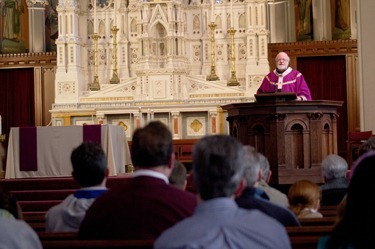


– – –
Then that evening I traveled to Washington to attend the spring meeting of the Board of Directors of Catholic University of America, which is the U.S. bishops’ university.

In the evening I was asked to address a men’s discernment group for those are considering the priesthood. I was happy that there were a couple of Boston lads in the group.
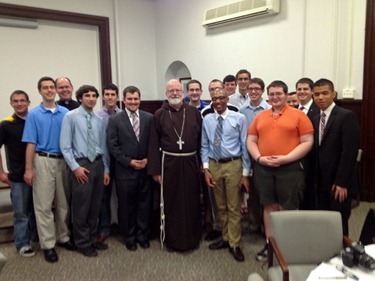
We had Vespers and dinner and then I gave a presentation on my own vocation. Afterwards, we had a dialogue on priestly vocation discernment. This was just another encouraging example of the ways Catholic University is really trying to promote its Catholic identity, encouraging both the young men and women to be conscious of their personal vocations and their Catholic faith.
– – –
On Wednesday I met with Hugh Dempsey of the Holy Land Christian Ecumenical Foundation. He works with the Patriarch of Jerusalem particularly to help the schools that are run by the Franciscans and patriarchate in the holy land.
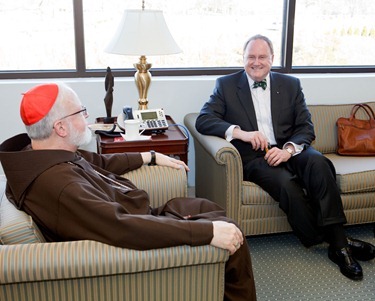
We had a very good conversation about the work the foundation is doing.
He also brought a very nice Stations of the Cross made by Christians in the Holy Land.
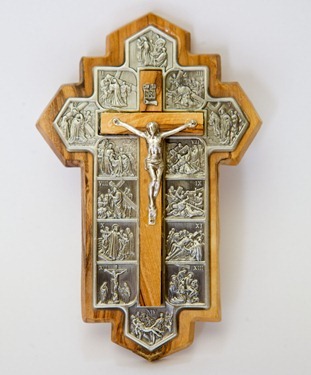
– – –
Finally, Wednesday evening we had our meeting of the Archdiocesan Pastoral Council. The Archdiocesan Pastoral Council is akin to a parish council, but at the diocesan level. It is an opportunity to receive input different segments of the population, especially the lay and religious of the archdiocese.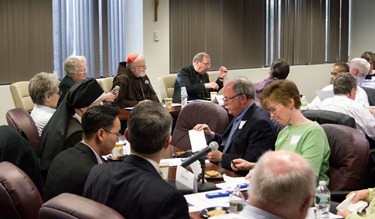
As part of our meeting, Father Paul Soper made a presentation on pastoral planning and we had a very animated discussion on the subject. 
We also had a session in which members of the pastoral Council are able to bring their concerns and messages to the Archbishop and the archdiocese. 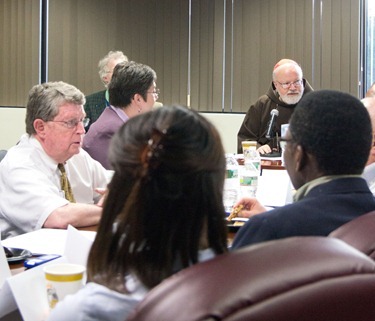
It was a very fruitful meeting and, as always, we are very grateful to the APC members for their contributions and dedication.
Until next week,
Cardinal Seán
